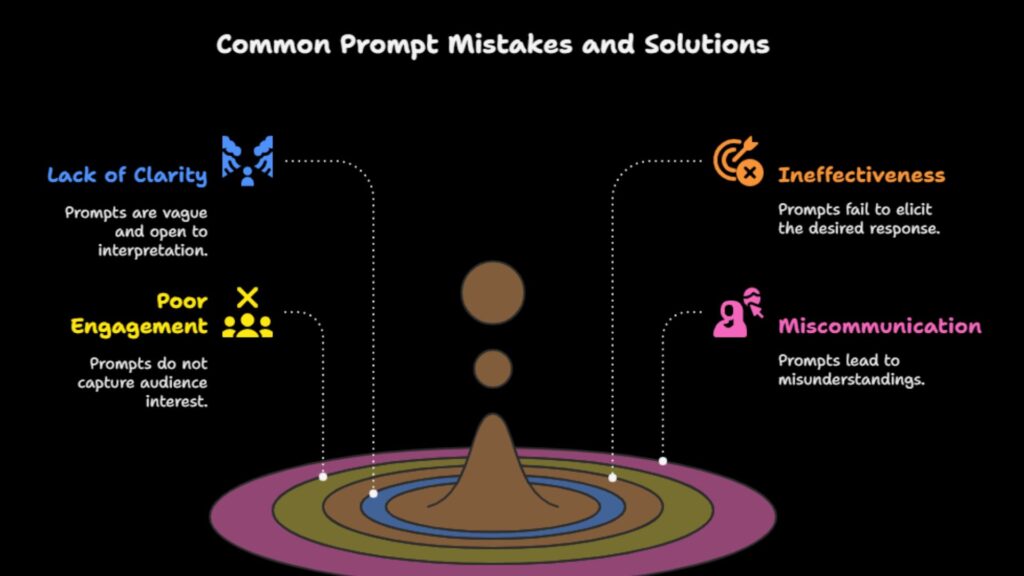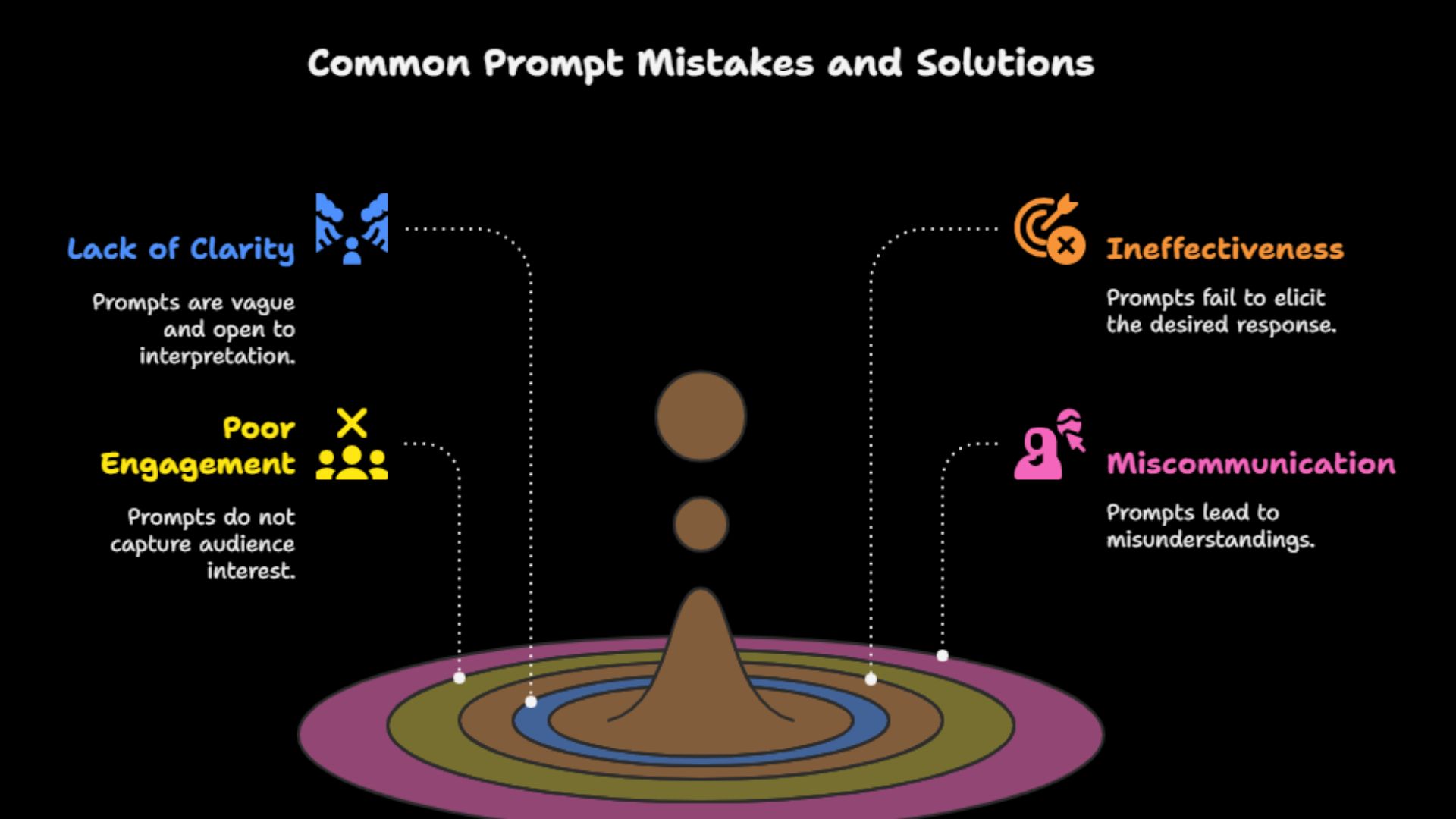Have you ever asked an AI tool like ChatGPT, Gemini or an image generator to make something and the result they provided was completely off from your expectathttps://openai.com/ions? It can feel as if the AI is just lost and does not get you.
But the truth is, most of the time the blame cannot go to the AI itself. The difficulty usually stems from how the instructions, or “prompts” have been written.
The problem for many newcomers lies elsewhere, which is a good sign. With us, they can be confident that they would be offered assistance in the specific areas they want to work on best—writing precise, powerful prompts so they can get their maximum from AI technology. Through some importhttps://promplix.com/how-to-write-effective-prompts-for-chatgpt-and-other-ai-tools/ant principles, guiding AIs to get the best results will be easy. You will be more confident when dealing with machine learning and receive accurate results for the tasks at hand every time.

Let’s dive into the 10 most frequent “prompt mistakes” and how to fix them.
1. Being Too Vague (The “Guessing Game” Mistake)
This is the biggest “mistake in prompt engineering“! If you are not clear, the AI has to guess what you mean, and it often guesses wrong. This leads to “generic AI responses.”
- Mistake: “Write about animals.”
- Fix: “Write a short, and funny story (300 words) about a short-tempered cat who secretly loves playing with a laser pointer.”
- How to fix bad prompts: Be specific! Tell the AI exactly what you want, including details like length, tone, and main characters. This is all about “adding specificity to prompts.”
2. Forgetting Context (The “Missing Information” Mistake)
AIs don’t know what you’re thinking. If you don’t give them enough background information, their answers won’t be very helpful. This is a common “lack of context in prompts.”
- Mistake: “Give me advice about going to school.” (What kind of school? What problem are you facing?)
- Fix: “Middle school is beginning for me next week and I’m anxious about the whole friend situation. Can you provide me with 3 easy tips to strike conversations with new people?”
- How to fix bad prompts: Always remember “providing context to AI.” Tell the AI the situation, who you are, or what the purpose of the output is.
3. Asking Too Many Things at Once (The “Overwhelm” Mistake)
Trying to cram too many different requests into one prompt can confuse the AI. This is where “overly complex prompts” trip things up.
- Mistake: “Write a story about a dragon, then explain how engines work, and tell me a joke.”
- Fix: Break it down!
- “Write a short, exciting adventure story about a kind dragon.””Explain the process of how an automobile engine turns the car wheels using basic language.””Share with me the most hilarious joke you know about robots.”
- How to fix bad prompts: “Breaking down complex tasks” is key. Give the AI one main job at a time. This is part of “structured prompting.”
4. Not Telling the AI Its Role (The “Who Are You?” Mistake)
AIs can often act like different characters. If you do not provide them with a persona to take on, their response may not match your requirements.
- Mistake: “Explain how photosynthesis works.”
- Fix: “Picture yourself as a warm, approachable science teacher talking to a class of 10-year-olds. Explain how it works using simple words and one example.”
- How to fix bad prompts: “Setting constraints for AI” and telling it to “act as” someone helps it choose the right style and tone.
5. Not Defining the Output Format (The “Messy Answer” Mistake)
89/ 200 WordsCustomizeHumanizeResult
Without proper instructions, an AI risks producing a lengthy single paragraph when you were expecting a list, as an example.
- Mistake: “Tell me about the planets.” is not quiet right.
- Fix: “List the eight planets in our solar system, starting from the closest to the sun, and include one interesting fact about each, in a bulleted list.”
- How to fix bad prompts: The output can be improved by thinking of it in terms of eliminating gaps, or “defining desired output.” Is it a poem, an email, or maybe a brief paragraph? Specify what the AI should generate.
6. Using Ambiguous Words (The “Huh?” Mistake)
Some words can have many meanings. If you use them without clarifying, the AI might pick the wrong meaning.
- Mistake: “Draw a cool picture.” (“Cool” could mean temperature, or awesome!)
- Fix: “Draw an awesome picture of a superhero flying through the sky at sunset, with bright orange and purple colors.”
- How to fix bad prompts: Be specific with adjectives. Rather than “good” or “bad,” use words that paint a clear picture for the AI. This boosts “clarity in AI prompts.”
7. Not Specifying Length (The “Too Long/Too Short” Mistake)
AIs do not know whether you need an answer that is limited in scope or extensive.
- Mistake: “Write an article about healthy eating.”
- Fix: “Write a short blog post (around 200 words) targeted for children explaining the importance of eating fruits and vegetables.”
- How to fix bad prompts: Always specify to the AI the desired length of the response e.g. ’50 words’, ‘three paragraphs’, ‘a short story’.
8. Not Giving Examples (The “Figure It Out Yourself” Mistake)
Sometimes, the most effective method to explain to the AI what you need is to provide an sample of the style or template.
- Mistake: “Write a riddle about a key.”
- Fix: “Here’s a riddle: ‘I have cities, but no houses; forests, but no trees; and water, but no fish. What am I?’ (A map). Now, write a similar riddle about a cloud.”
- How to fix bad prompts: “Using examples in prompts” is a powerful way to guide the AI, especially for creative tasks.
9. Not Iterating or Refining (The “One-Shot” Mistake)
Many beginners write one prompt, and if it’s not perfect, they give up. But becoming an “effective prompt strategy” user means refining! This is called “iterative prompting.”
- Mistake: “Write a poem about rain.” (If it’s not quite right, you might stop there.)
- Fix: “Write a poem about rain.” -> “Make it happier.” -> “Now make it rhyme.” -> “Add a line about a rainbow.”
- How to fix bad prompts: Don’t be afraid to keep talking to the AI. Tell it what you liked, what you didn’t, and what to change. This is how you “improve AI prompts” and even “debug AI prompts.”
10. Expecting AI to Be Human (The “It Knows Everything” Mistake)
AIs are incredibly smart, but they are still machines. They don’t have feelings, personal experiences, or common sense like humans. Sometimes, an AI might even “hallucinate” – that’s a funny way of saying “when AI makes things up.”
- Mistake: Asking personal opinions or expecting it to understand complex human emotions without clear instructions.
- Fix: Focus on factual information, creative tasks, or specific roles. If asking for opinions, tell it to present them as a factual overview.
- How to fix bad prompts: Remember “understanding AI limitations.” AIs are tools, and they work best when used for their strengths. Your goal is “enhancing AI communication” by knowing what AI can and cannot do well.
Avoiding Mistakes: The Path to AI Success
By learning to avoid these common “prompt mistakes,” you’ll notice a huge difference in your AI interactions. You’ll go from getting “irrelevant AI outputs” to “getting accurate AI results.” This means “saving time with AI” and truly “maximizing AI tool performance.”
At Promplix.com, we are dedicated to helping you master the “AI prompt learning curve.” Our platform provides “prompt correction tips” and tools to help you with “writing better AI prompts” so you can effortlessly talk to AI systems like ChatGPT, Gemini, Copilot, Claude, Deepseek, and Grok. Get ready for “improved AI understanding” and much better results.

